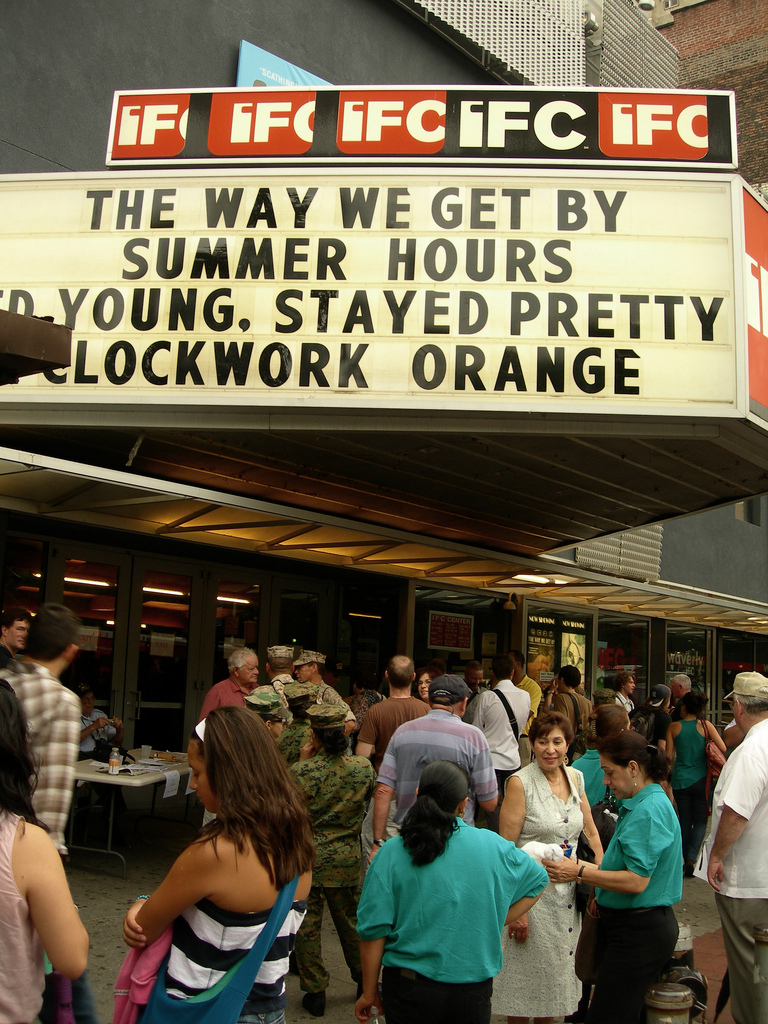Today’s guest post is from filmmakers Gita Pullapilly and Aron Gaudet.
With film prints in hand, it now changed our game plan. Though we knew likely we’d lose money realizing nationally in theaters, we were banking that the film reviews and national press would bring a greater exposure to our film—and if not help our bottom line—at least help our careers.
In the end, we decided to alter our business plan, aware of the risks, and launched a national theatrical run.
The money we had made in Maine allowed us to bring on International Film Circuit as our distributor for a national release.
Our national non-profit partners couldn’t provide any financial support to us, however they shared film and screening information with their members by email, on their websites, and on their social networks. Now it wasn’t just us tweeting something or adding an event to our Facebook fan page to our few thousand followers. It was a large network of organizations reaching hundreds of thousands of people.
During this time, were bringing in interns as fast as we could to help us make calls to colleges across the country. Our plan was to allow them to use our film as a “real-life” marketing project for students. Instead of some example from a book, they would evaluate the best ways to release our film in their state—where to play, how to plan for a local release, identify target groups to work with—and then see if their plan actually worked in real life. In return, we would give the schools and the students credit at the end of our film. They all had to deliver reports to us by a specific deadline to get in the final theatrical credits. Although we initially had commitments from about 20 schools, 14 actually had extended conversations with us, and seven schools in seven different states delivered marketing research that was usable. The schools gave us insight into many different communities as we rolled the film out. In addition, the students helped spread the word because they now had a stake in the film’s success—and wanted friends and family to see their names in the credits.
What we discovered as we opened was that even though our research was solid, it was really difficult to get our target groups out to the theatre. We began to fear that the studios we talked to were right—grassroots has little impact on the box office.
In July, we kicked off our national run at the IFC Center in New York City, breaking over $7,000 in box office opening weekend and $10,000 for the week. International Film Circuit believed that was a solid number to work with—along with the numerous festival awards we had now won—to open The Way We Get By in more theatres across the country. As the bookings for the film started to pile up, we began to gain more confidence. That didn’t last too long.
In August, we opened at Laemmle’s Music Hall in Los Angeles and got killed. The theatre is located in a very affluent Jewish neighborhood in the heart of Beverly Hills. Crowds of elderly Jewish people came in droves to the theater to see films that weekend—just not ours.
Yoo-Hoo Mrs. Goldberg about a Jewish radio pioneer was playing, and Woody Allen’s latest film Whatever Works opened the same weekend as we did. It was tough to see a lobby filled with senior citizens and know they were not there to see our film…with three subjects all over 70 years old.
All in all, over five months, from July – November (leading up to our Veterans Day POV broadcast), we opened in over 60 cities, spending every penny we made in Maine on marketing and promotion. New York and Los Angeles were, by far, the most expensive—hiring PR firms, placing qualifying ads, and putting on special events ended up costing thousands.
In key markets, our screenings became more of an event. In NYC and L.A., we provided special group discounts.
We did “red carpet” events for troops, veterans, and seniors. We deployed our interns across each city, pitching to local groups that had any connection to the film. In Washington, DC, days before our theatrical opening, we had a special screening on Capital Hill with POV, the USO, and Hands On Network as our partners. It garnered national press and the next day, we received an invitation to the White House to meet with Vice President Biden. That visit was not only an incredible, lifetime experience; it also helped spread the word about the film.
But now the film was also going to create an amazing personal opportunity for us as well…..
END PART IV. Part V, and the conclusion of the series, is tomorrow with:
GOING LOCAL PAYS OFF
:
Part One: Finding A Spot In The Line-Up
Part Two: Timing Is Everything
Part Three: Going Local & Maximizing Your Distribution Window
Part Four: Minimize Your Loss And Hope For A Greater Payoff In The End
Part Five: Going Local Pays Off
Gita Pullapilly and Aron Gaudet are now working on their next project—a narrative feature, “Go Baby” they plan to shoot early next year. They recently launched SUNNY SIDE UP FILMS, www.sunnysideupfilms.com, which also supports the national distribution of independent films.
Tune in to see The Way We Get By for its encore presentation as part of the 2010 season on POV August 3, 2010. For more information, visit: www.thewaywegebymovie.com







